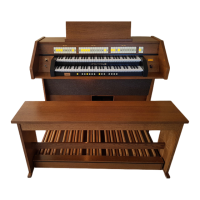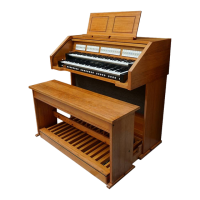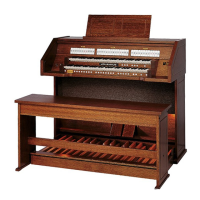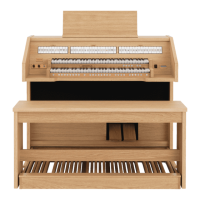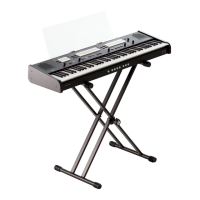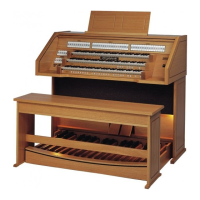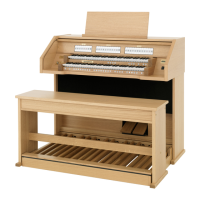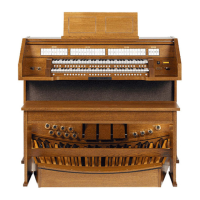Do you have a question about the Johannus Opus 30 and is the answer not in the manual?
Describes the construction and materials of the organ cabinet.
Details the console's layout, keyboards, and accessories.
Information on the 32-note AGO pedalboard and its installation.
Instructions for safely connecting the organ to a power source.
Steps for powering on the organ and initial system checks.
Diagram and labeling of controls specific to the Opus 5 AGO model.
Diagram and labeling of controls for Opus 10 and 20 AGO models.
Diagram and labeling of controls for the Opus 30 AGO model.
Explanation of how couplers link different keyboard divisions.
Details the function of tremulants for vibrato and expression.
Introduction to programmable MIDI-stops for external control.
Classification and examples of flue pipe stops (Principals, Strings, Flutes).
Explanation of reed pipe stops and their resonators.
How to use the main VOLUME control for overall sound level.
Operation of expression pedals for Swell, Choir, Great, and Pedal.
How to program and recall registrations using SET and memory pistons.
Functionality of the 0 piston for undoing actions or clearing settings.
How to adjust the organ's tuning and temperament.
Functionality for transposing the organ's pitch.
Enabling memory lock for saving and modifying registrations.
Details on MIDI IN, MIDI MOD., and MIDI SEQ. ports.
Headphone jack for private listening and automatic speaker muting.
Explanation of the standard equal temperament and its suitability for all keys.
Details on Werckmeister III, its historical use, and character.
Information about Meantone temperament and its historical context.
Step-by-step guide to programming personal registrations.
Explanation of MIDI technology and its components.
Guidance on connecting external devices via MIDI.
Detailed steps for manually programming MIDI stops.
Instructions for cleaning the organ's wooden parts and keys.
Specifications for voices, keyboards, and amplification.
Details on capture system, MIDI features, and controls.
Summary of external connection options and specifications.
Key dimensions of the organ cabinet including height, width, and depth.
Describes the construction and materials of the organ cabinet.
Details the console's layout, keyboards, and accessories.
Information on the 32-note AGO pedalboard and its installation.
Instructions for safely connecting the organ to a power source.
Steps for powering on the organ and initial system checks.
Diagram and labeling of controls specific to the Opus 5 AGO model.
Diagram and labeling of controls for Opus 10 and 20 AGO models.
Diagram and labeling of controls for the Opus 30 AGO model.
Explanation of how couplers link different keyboard divisions.
Details the function of tremulants for vibrato and expression.
Introduction to programmable MIDI-stops for external control.
Classification and examples of flue pipe stops (Principals, Strings, Flutes).
Explanation of reed pipe stops and their resonators.
How to use the main VOLUME control for overall sound level.
Operation of expression pedals for Swell, Choir, Great, and Pedal.
How to program and recall registrations using SET and memory pistons.
Functionality of the 0 piston for undoing actions or clearing settings.
How to adjust the organ's tuning and temperament.
Functionality for transposing the organ's pitch.
Enabling memory lock for saving and modifying registrations.
Details on MIDI IN, MIDI MOD., and MIDI SEQ. ports.
Headphone jack for private listening and automatic speaker muting.
Explanation of the standard equal temperament and its suitability for all keys.
Details on Werckmeister III, its historical use, and character.
Information about Meantone temperament and its historical context.
Step-by-step guide to programming personal registrations.
Explanation of MIDI technology and its components.
Guidance on connecting external devices via MIDI.
Detailed steps for manually programming MIDI stops.
Instructions for cleaning the organ's wooden parts and keys.
Specifications for voices, keyboards, and amplification.
Details on capture system, MIDI features, and controls.
Summary of external connection options and specifications.
Key dimensions of the organ cabinet including height, width, and depth.
| Number of Manuals | 2 |
|---|---|
| Number of Stops | 30 |
| Pedalboard | Yes |
| Sound Generation | Digital Sampling |
| MIDI | Yes |
| Voices | Multiple |
| Weight | 125 kg / 275.6 lbs |
